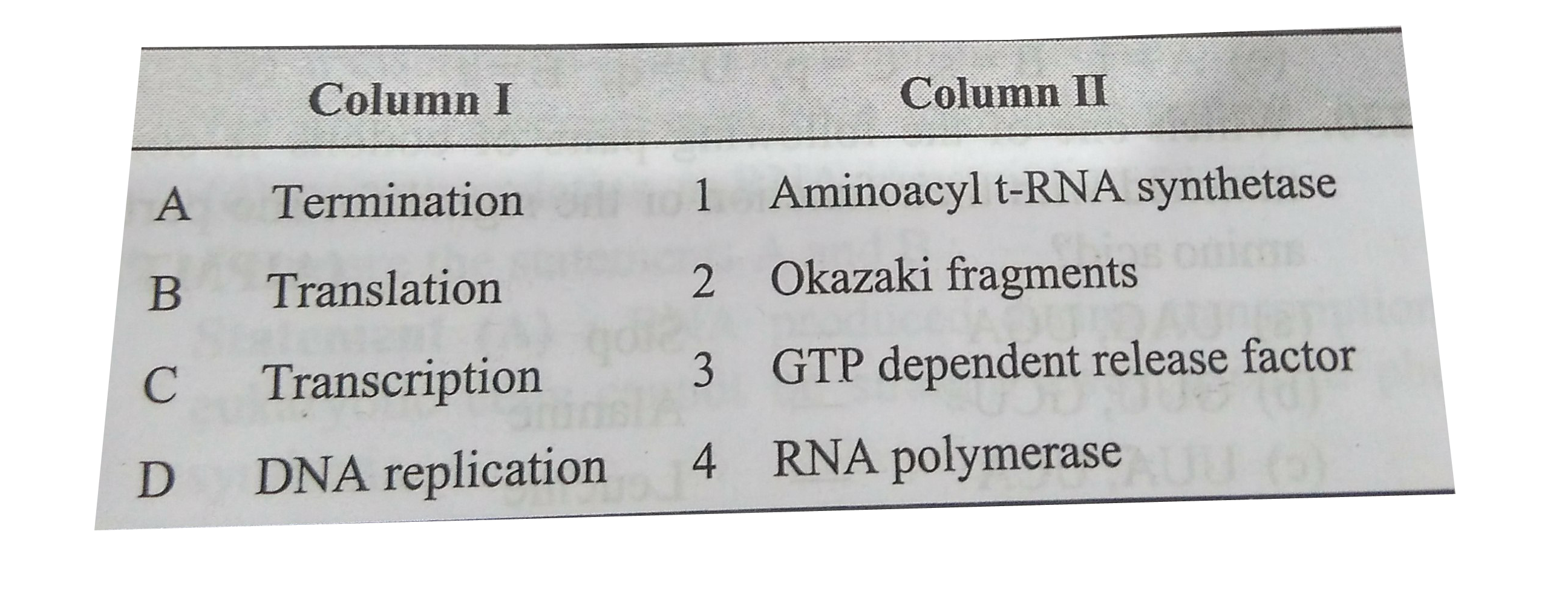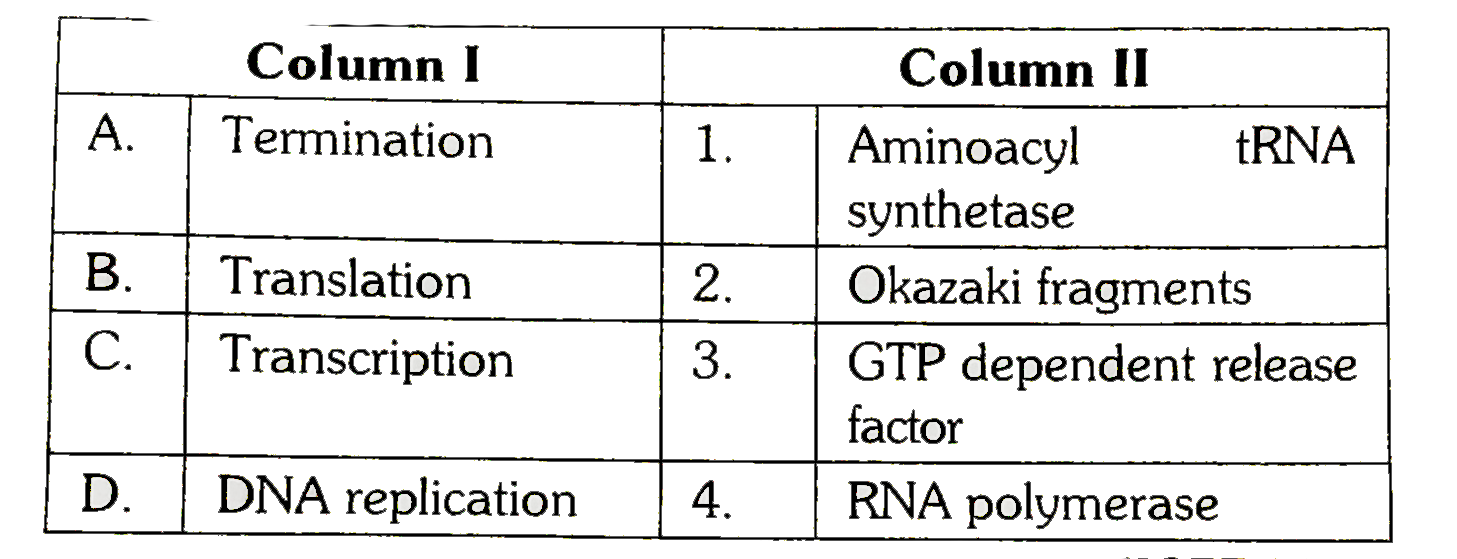Match the following with correct combination
ColumnIColumnIIA.Mutualism1.Tiger and DeerB.Commensation 2.Cuscuta and CissusC.Parasitism3.Sucker fish and shark D.Predation4.Crab and sea anemone
A-1 , B-2 , C-3 , D-4
A-4 , B-3 , C-2 , D-1
A-1 , B-3 , C-2 , D-4
A-2 , B-3 , C-1 , D-4
The correct Answer is:B
To solve the matching question, we need to identify the correct relationship between the types of interactions in Column I and their corresponding examples in Column II. Let's analyze each interaction step by step.
1. Mutualism (A):
- Definition: A symbiotic relationship where both organisms benefit from each other.
- Example: Crab and sea anemone. The sea anemone provides protection to the crab, and in return, the crab helps the sea anemone by providing mobility and access to food.
- Match: A - 4 (Crab and sea anemone).
2. Commensalism (B):
- Definition: A relationship where one organism benefits while the other is neither helped nor harmed.
- Example: Sucker fish and shark. The sucker fish attaches to the shark for transportation and consumes leftover food without affecting the shark.
- Match: B - 3 (Sucker fish and shark).
3. Parasitism (C):
- Definition: A relationship where one organism benefits at the expense of the other.
- Example: Cuscuta (a parasitic plant) and Cissus (the host plant). Cuscuta derives nutrients from Cissus, harming it in the process.
- Match: C - 2 (Cuscuta and Cissus).
4. Predation (D):
- Definition: A relationship where one organism (the predator) kills and eats another organism (the prey).
- Example: Tiger and deer. The tiger hunts and kills the deer for food.
- Match: D - 1 (Tiger and Deer).
Final Matches:
- A - 4 (Mutualism - Crab and sea anemone)
- B - 3 (Commensalism - Sucker fish and shark)
- C - 2 (Parasitism - Cuscuta and Cissus)
- D - 1 (Predation - Tiger and Deer)
Summary of Matches:
- A: 4
- B: 3
- C: 2
- D: 1
- Definition: A symbiotic relationship where both organisms benefit from each other.
- Example: Crab and sea anemone. The sea anemone provides protection to the crab, and in return, the crab helps the sea anemone by providing mobility and access to food.
- Match: A - 4 (Crab and sea anemone).
- Definition: A relationship where one organism benefits while the other is neither helped nor harmed.
- Example: Sucker fish and shark. The sucker fish attaches to the shark for transportation and consumes leftover food without affecting the shark.
- Match: B - 3 (Sucker fish and shark).
- Definition: A relationship where one organism benefits at the expense of the other.
- Example: Cuscuta (a parasitic plant) and Cissus (the host plant). Cuscuta derives nutrients from Cissus, harming it in the process.
- Match: C - 2 (Cuscuta and Cissus).
- Definition: A relationship where one organism (the predator) kills and eats another organism (the prey).
- Example: Tiger and deer. The tiger hunts and kills the deer for food.
- Match: D - 1 (Tiger and Deer).
- A - 4 (Mutualism - Crab and sea anemone)
- B - 3 (Commensalism - Sucker fish and shark)
- C - 2 (Parasitism - Cuscuta and Cissus)
- D - 1 (Predation - Tiger and Deer)
- A: 4
- B: 3
- C: 2
- D: 1
Topper's Solved these Questions
- BOOK - PRADEEPCHAPTER - ORGANISMS AND POPULATIONS EXERCISE - Practice Questions (II. Assertion - Reason Type Questions)18videos
ORGANISMS AND POPULATIONS
- BOOK - PRADEEPCHAPTER - ORGANISMS AND POPULATIONS EXERCISE - Analytical (Questions with Answers)20videos
ORGANISMS AND POPULATIONS
- BOOK - PRADEEPCHAPTER - ORGANISMS AND POPULATIONORGANISMS AND POPULATIONSEXERCISE - Additional Questions (Very Short Answer Questions)1videos
ORGANISMS AND POPULATIONORGANISMS AND POPULATIONS
- BOOK - PRADEEPCHAPTER - PRINCIPLES OF INHERITANCE AND VARIATION EXERCISE - ASSERTION-REASON TYPE QUESTIONS15videos
PRINCIPLES OF INHERITANCE AND VARIATION
Similar Questions
Knowledge Check
- Question 1 - Select One
Match the following in column I with column II and choose the correct combination :
 AA=2,B=3,C=1,D=4BA=1,B=4,C=4,D=3CA=3,B=1,C=4,D=2DA=4,B=2,C=1,D=3
AA=2,B=3,C=1,D=4BA=1,B=4,C=4,D=3CA=3,B=1,C=4,D=2DA=4,B=2,C=1,D=3 - Question 2 - Select One
Match the following and select the correct combination.
Column IColumn IIA.Red algae(i)MarchantiaB.Liver wort(ii)PinusC.Walking fern(iii)PolysiphoniaD.Gymnosperm(iv)AdiantumAA-(i), B-(ii), C-(iv), D-(iii)BA-(ii), B-(iv), C-(iii), D-(i)CA-(ii), B-(iii), C-(i), D-(iv)DA-(iii), B-(i), C-(iv), D-(ii) - Question 3 - Select One
Match the following columns
Column-IColumn-II(Population interaction)(examples)Amutualism1ticks on dogsBcommensalism2Balanus and chathamalusCparasitism3sparrow and any seedDcompetition4epiphyte on a mango branchEpredation5Ophrys and beeAABCDE15432BABCDE21543CABCDE32154DABCDE54123
Match the following column with correct combination.
Column IColumn IIA Anthoceros1. AlgaB Adiantum2.HornwortC Sargassum3. GametophyteD Prothallus4. InferaeE Asterales5. Walking fernView SolutionMatch the following and select the correct option from the codes gives below.
Column−IColumn−IIA.Physalia(i)Sea anemoneB.Meandrina(ii)Brain coralC.Gorgonia(iii)Sea fanD.Adamsia(iv)Portuguese man of warView SolutionMatch the following in column I with column II and choose the correct combination
ColumnIColumnIIA.Xylem vessels1Store food materialsB.Xylem trachieds2Obliterated lumenC.Xylem fibre3Perforate platesD.Xylem parenchyma4Chisel-like endsView SolutionMatch the columns I and II, and choose the correct combination from the options given.
Column IColumn IIApomixis1.MangoPolyembryony2.Seedless fruitParthenocarpy3.AsteraceaeView SolutionMatch the following and choose the correct combination from the option given
Column IColumn IIA.Sulphuri.Chlorophyll2.zincii.Nitrogenase3.Magnesiumiii.Methionine4.Molybdenumiv.AuxinView Solution


